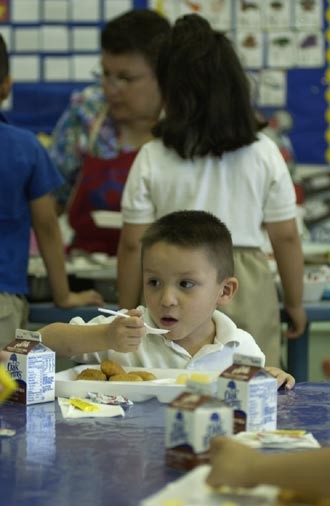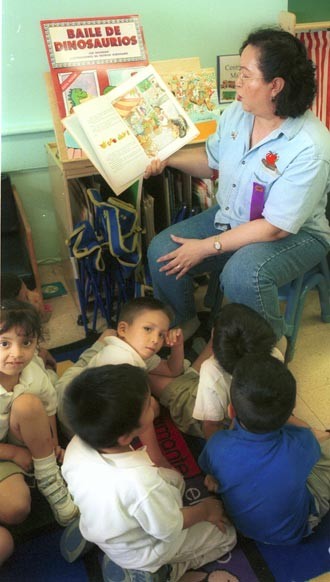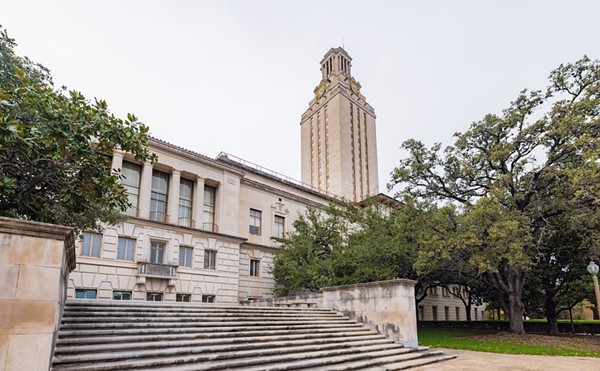"Duermase mi'jo," Valle repeatedly urges one boy before summoning him to her lap, where she cradles and gently rocks him. "Pobrecito, he just lost his father last year," she explains. The child falls asleep in less than a minute. Another sleepless girl gets the same treatment: Her mother is expecting a baby, and the child hasn't been thrilled about it lately. Soon, she too joins the slumber.
| Joseph, 5, enjoys a "family-style" meal with his classmates. Photo by Mark Greenberg |
Looking at their peaceful, innocent faces, it's difficult — even frightening — to realize that they have already been identified as "at risk" children. At risk of flunking a grade, dropping out of school, getting pregnant early. At risk of becoming criminals, using drugs, living the rest of their lives in poverty. It's easy for society to feel sorry for them, but it's hard to help them. Yet that's exactly why they're here — to get a head start that others had in life and remove the label they've been tagged with at such an early age.
Getting a fair break
Valle's class at Austin Elementary is one of 58 offering free Early Childhood Education (ECE) to 3 and 4 year olds in the San Antonio Independent School District. The program was implemented five years ago, with only 400 children attending a half-day program; it has since grown to a full day of schooling for more than 2,700 students. The purpose of starting early is to feed a child's brain, which learns and retains the most information during the first three years of life. School board member and ECE advocate Connie Rocha says: "You're getting sponges that are just waiting to be filled in."
Years before the ECE program began, many SAISD educators noticed a growing need to put children in school before the legally required age of 6. Early childhood education was one of many ideas suggested to combat the district's track record of low test scores and high dropout rates. Rocha explained that many of their students, who are bilingual and come from Spanish-speaking families, have not been adequately prepared with the proper vocabulary for reading and testing. "A lot of these parents must also work two jobs, so it's been difficult for our kids to get a fair break," she said.
Play all day
The daily routine in Valle's classroom illustrates the range of activities occurring in ECE class. Instructors follow a detailed, research-based curriculum that was carefully developed by a group of early childhood educators in the district. The day begins with a few brief activities, followed by breakfast, which the kids enjoy in the comfort of their own room. Most of the day is then free for students to roam about the room, and to try out various activities set up for them in eight different learning centers: computers, music, drama, housekeeping, writing, fine arts, listening, and library.
| Irma L. Gonzales holds most of the children's attention during storytime, one of few large group activities. Kara, 3, left, and Cesar, 5, right, are entranced by a camera. Photo by Mark Greenberg |
The computer center contains two PCs that feature kids' learning programs. Kids use cassette tapes and instruments in the music area, while at the drama center, children produce finger puppet plays. In the housekeeping section, boys and girls pretend to prepare food, wash clothes, and care for multi-ethnic dolls in a home-like setting. Spelling and writing are done in a section equipped with an oversized paper tablet, chalkboard, and dry erase board.
A fine arts center, stocked with construction paper, child-safe scissors, glue, crayons, colored pencils, and markers allows children to express themselves creatively. Students go to the listening area to hear books on tape. And finally, at the comfy library center, children can browse through shelves of large, colorful books and plop down on fluffy floor pillows to read.
At times, the group gathers for story-telling, song-singing, or role-playing. They recite the basics, such as days of the week, months of the year, seasons, numbers, sounds, and letters. Then it's either back to the learning centers or time for "active play," which is designated for students can hone their coordination, usually outdoors, but again separate from regular physical education with older kids.
"If you ask the kids what they do at school, they'll tell you they play all day," shares Austin Elementary School's principal Maribel Rodriguez, "Well, that's what early childhood is all about, learning through playing."
Somewhere between playing and napping comes lunchtime. Like breakfast, lunch is also delivered to the classroom on a cart, so that younger students are spared the minor chaos of a school cafeteria and instead, are able to enjoy what the ECE curriculum calls "family-style" meals. The children help set the miniature tables with milk, napkins, straws, and plastic utensils, while the teacher serves each child individually. Valle asks her students to count the number of tator tots and pineapple chunks on the small trays. She makes certain they've chosen at least three of the five food groups, which include a meat, a grain, a fruit, a vegetable, and dairy.
"We want them to sit around the table, to eat and talk with the children, and to use that time as an opportunity for learning skills as well as manners," said Mary Helen Rodriguez, an administrator in SAISD's food services division.
The system works beautifully in Valle's class. She questions her students on the color of the broccoli and the shape of the carrot slices, while assuring no one's hungry or left out of the conversation. And she guides the class in a daily routine of cleaning up, washing their hands, and brushing their teeth after meals.
Valle teaches these concepts in Spanish and English, since she oversees the bilingual class. (ECE curriculum assures Spanish speakers are only gradually introduced to a second language so that they master both languages by the third grade.) Like a proud mother, she shows off mini books her kids have composed, artwork, photos of their dance recital. "They have a lot of rhythm since they listen to music all day and sing and dance along," she boasts.
The payoff
Educators claim there is a noticeable difference between children who have received an early childhood education and those that have not. The kids enter primary school better-behaved, with a sense of order and routine, an awareness of phonetics, listening and verbal skills, and an understanding of numbers.
Programs like ECE provide thousands of children with two nourishing meals everyday. They also teach hygiene and manners, and their enrollment requirements ensure the kids receive their childhood immunizations. At the same time, ECE is providing a basic and necessary childcare service that enables parents to work or attend school.
SAISD superintendent Dr. Ruben Olivarez says that while the program has allowed the district to develop relationships with parents, some still require convincing. "There's this mindset that we're taking away the parents' responsibility to bring up their own children," he said, "But in fact, we know that it's a very necessary intervention that we have to provide, especially for some populations — a large population in our case."
Even City officials have applauded SAISD's efforts and hope other districts follow suit. Last year's bond package assured the district $26 million to build separate facilities for the ECE program, and the Office of Community Initiatives is collaborating with them to provide after school care and parent outreach programs. Director Dennis Campa called ECE a cornerstone for building a prosperous future generation adding, "The City is making all these other efforts in the interim — job training, scholarships, literacy programs — but the biggest payoff happens when we begin in the beginning."




















